Page 1 of 2
Article courtesy of Fisher & Phillips
As the weather gets warmer and you shift your focus to seasonal hiring, you’ll want to be sure to connect with Gen Z applicants, many of whom are college and high school students in search of summer jobs. These workers are “digital natives” who grew up with technology and social media, and as a result, have their own work preferences, influences, and slang that can be somewhat baffling to outsiders. Do you want to bridge the generational divide and create a welcoming and legally compliant workplace for all? Here’s your guide to hiring Gen Z this summer.
Gen Z Has Clocked In – and They Have Notes!
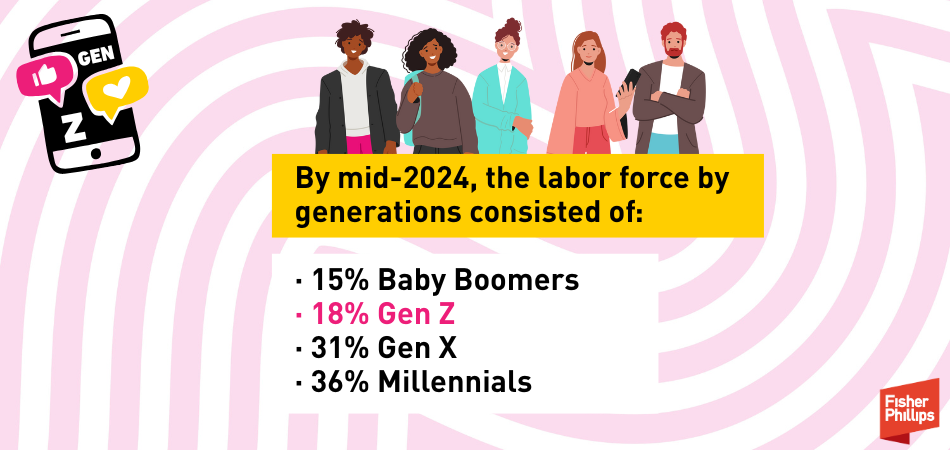
Gen Z is generally defined as people born between 1997 and 2012, which means members of this generation will turn 13 to 28 this year – and their presence in the workplace is growing rapidly. According to data from the U.S. Department of Labor, Gen Z surpassed Baby Boomers in the workforce for the first time in 2023. By mid-2024, the labor force by generations consisted of:
This means your hiring managers will want to understand what motivates Gen Z and what keeps them engaged. Here are six major points to keep in mind – with the caveat that every individual is different, some attributes are based on life-stage, and others are applicable to everyone, regardless of generation.
1. Sus Emails Are Not the Vibe – PERIODT
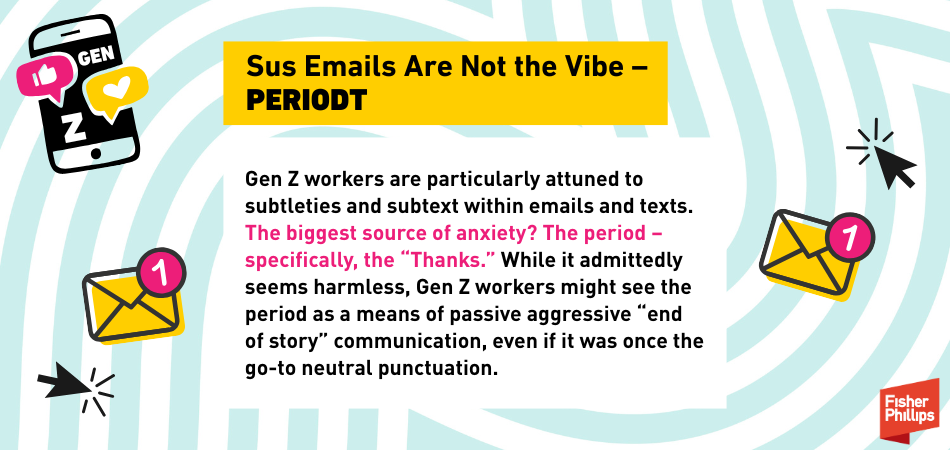
Gen Z has been communicating electronically since the womb, essentially. This means Gen Z workers are particularly attuned to subtleties and subtext within emails and texts. The biggest source of anxiety? The period – specifically, the “Thanks.” While it admittedly seems harmless, Gen Z workers might see the period as a means of passive aggressive “end of story” communication, even if it was once the go-to neutral punctuation. Using more exclamation points in communication might seem excessive to other generations, but it could make your newer Gen Z employees feel welcome and mitigate unnecessary stressors.
2. When We Excel, Let Us Know!

Gen Z doesn’t need to be coddled but making them feel like valued members of the team can go a long way. When providing coaching and training, consider doing so in a way that is constructive and growth minded. Everyone likes to know that the work they do is seen and appreciated. Even when feedback is negative, being thoughtful and constructive can encourage a team-oriented mindset that will help build confidence and ultimately lead to better work product.
3. Fully Remote Work Can Be Pretty Mid
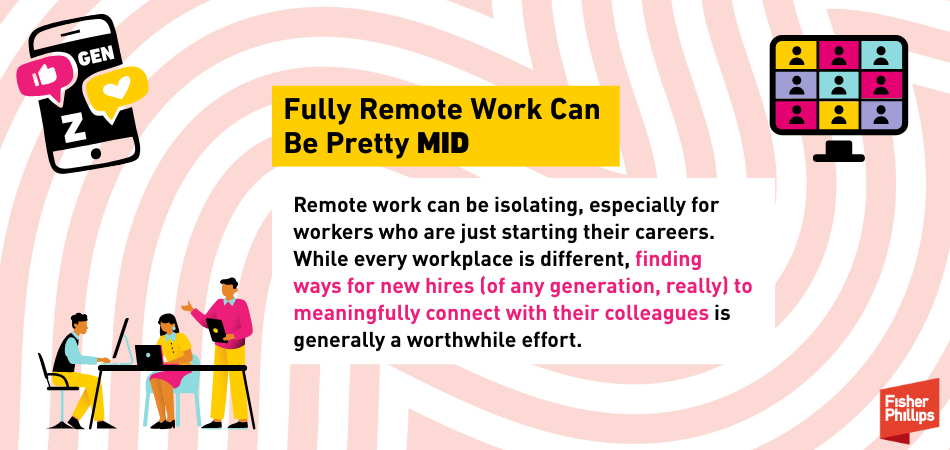
COVID-19 may be in the rearview mirror, but it has forever changed the way we work. While Gen Z workers don’t necessarily want to be in the office five days a week, having a fully remote workforce also poses challenges. Remote work can be isolating, especially for workers who are just starting their careers. While every workplace is different, finding ways for new hires (of any generation, really) to meaningfully connect with their colleagues is generally a worthwhile effort. Consider developing mentorship pairings, hosting in-person social events, and taking an extra minute at the end of the day to check-in 1:1. This can help foster a sense of camaraderie that, in turn, produces better work. Plus, this is a great opportunity to make Gen Z workers feel like they are respected members of the team and to boost your retention efforts.
4. Lacking Work-Life Boundaries is Cringe
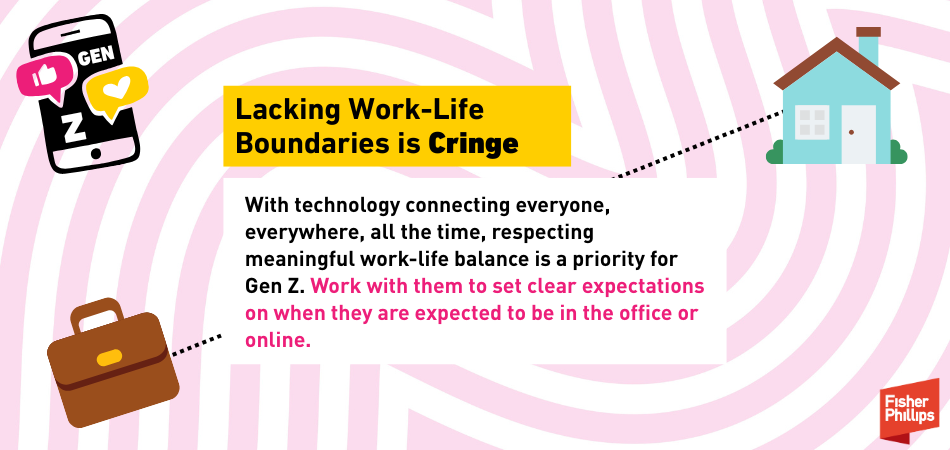
With technology connecting everyone, everywhere, all the time, respecting meaningful work-life balance is a priority for Gen Z. Simple things like delaying send on what would otherwise be a midnight email – or making it clear that workers are not obligated to respond after hours – can make a big difference. Work with them to set clear expectations on when they are expected to be in the office or online.
5. We Care About the Brand
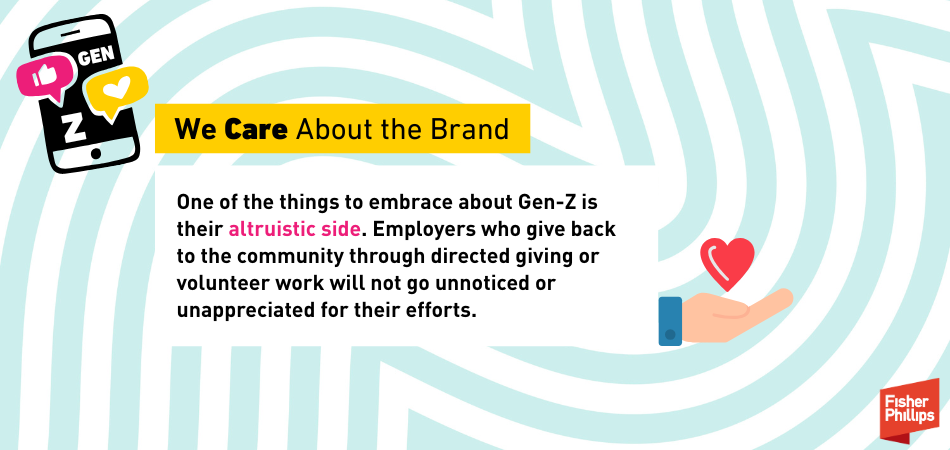
One of the things to embrace about Gen-Z is their altruistic side. Employers who give back to the community through directed giving or volunteer work will not go unnoticed or unappreciated for their efforts. Engaging your new hires in these activities is also an excellent team-building opportunity.
6. There are Pros and Cons to Being Chronically Online
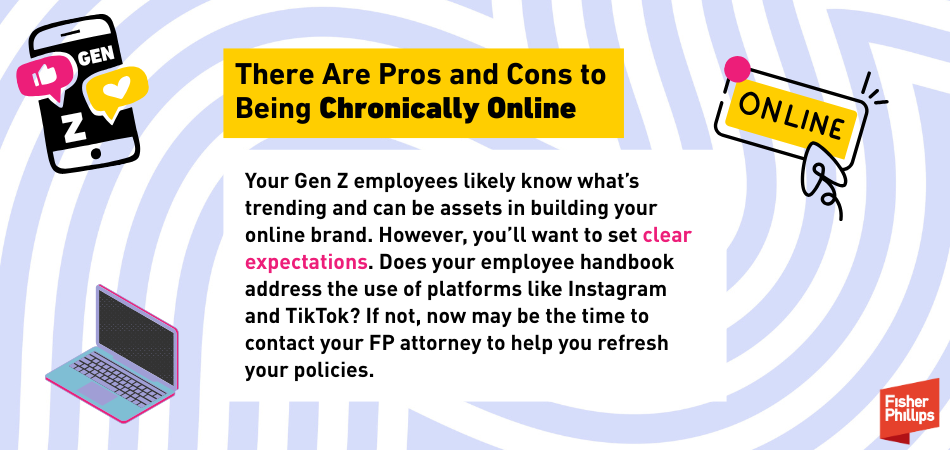
The association of Gen Z with social media is unavoidable. There can be incredible opportunity in wielding social media to your advantage. Your Gen Z employees likely know what’s trending and can be assets in building your online brand. However, you’ll want to set clear expectations. Does your employee handbook address the use of social media platforms? If not, now may be the time to contact your FP attorney to help you refresh your policies. Additionally, you can click here for four tips on updating your social media policies and staying on top of the latest trends.
At the end of the day, while Gen-Z is unique in many ways, all employees want to feel respected in their workplace. Creating a healthy, safe, and engaging environment for all employees is essential to maintaining a positive company culture. Read on for our specific tips for summer hiring.
What’s the Tea with Hiring Seasonal Workers?
Gen Z is represented by a range of workers who may approaching more senior levels of employment or still looking to land a summer job. If you’re looking to hire Gen Z workers when school lets out, you’ll want to keep the following tips in mind.
No Cap! A Bunch of Rules May Apply to Your Workplace
Here are six critical compliance items to add to your summer hiring checklist:
Give Your Policies and Procedures a Glow-Up
Have You Set Clear Expectations? Yes? Slay!
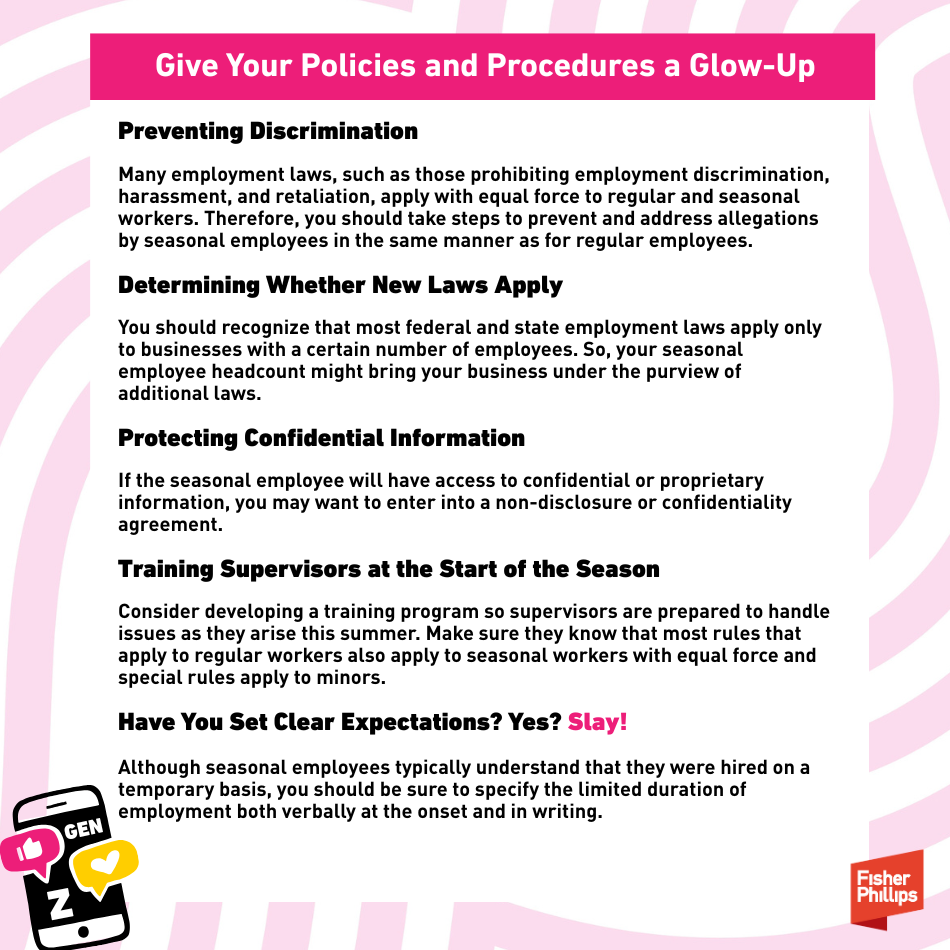
Due to ongoing COVID-19 concerns, employers will have the flexibility to remotely review employment documents for I-9 purposes in some circumstances until July 2023 — and they should keep using the current Form I-9 even though it was set to expire at the end of the month, according to two important announcements this week from the Department of Homeland Security (DHS). Here’s what you should know as we wait for additional DHS guidelines and prepare for anticipated changes.
Keep Using the Current Form I-9 — But Stay Tuned for Further Guidance
DHS notified employers that they should continue to use the current I-9 — which has an expiration date of October 31, 2022 — until further notice. So, stay tuned for additional information, as we will provide an update when DHS publishes its new Form I-9, associated instructions, and effective date.
Timely compliance will be critical, since failing to use the current version of Form I-9 can result in administrative penalties. You should be prepared to take immediate action and discard the current version when the new one goes into effect.
Relaxed Document Inspection Rules Remain in Play in Limited Circumstances
Due to continued safety precautions related to COVID-19, DHS announced that it will extend its updated I-9 flexibilities until July 31, 2023. Since early on in the COVID-19 pandemic, USCIS has allowed employers to remotely review — by Zoom, video chat, FaceTime, fax, or other electronic means — the identity and work-authorization documents that are necessary to complete employees’ I-9 forms during the hiring and reverification process. These “relaxed” rules have applied in the following situations:
Under these rules, employers must eventually inspect the relevant documents in person, but only if an employee stops working remotely and begins to report to the employer’s physical location on a regular, consistent, or predictable basis.
A Sign of Changes to Come?
This extension of the relaxed rules aligns with recent DHS efforts to kickstart the rulemaking process for a permanent protocol on remote document review. The latest extension of the relaxed document review rules is seen by some as more proof that DHS is dedicated to creating a permanent remote document examination rule. If implemented, the rule would allow employers to hire workers in far-flung locations, inspect their documents remotely, and eliminate the current requirement of in-person review by a company employee or authorized representative.
If you accepted expired forms of identification from new employees who completed their I-9 forms during the pandemic, your deadline for updating them with current proofs of identification is fast approaching. The Department of Homeland Security recently announced that it was winding down its temporary policy that had allowed for expired List B (proof of identification) documents to be used when completing I-9s because of COVID-related difficulties in renewing such I.D. documents. You have until July 31 to update your I-9 forms to get into compliance with the law. What do you need to know about this fast-approaching deadline?
How We Ended Up Where We Are
In response to the COVID-19 pandemic, the Department of Homeland Security issued a number of temporary policies easing Form I-9 compliance. One of them was the COVID-19 Temporary Policy for List B Identity Documents.
Under this policy, employers were allowed to accept expired List B (proof of identification) documents. Many state and local agencies were under lockdown, so it was difficult – if not impossible – for individuals to renew expired documents such as drivers’ licenses, school I.D. cards, Native American tribal documents, and others.
What’s Changed?
The Department rescinded this temporary policy on May 1 and began again to require employers to accept only unexpired List B documents. USICS recently announced that employers who accepted expired List B documents prior to May 1, 2022, will have until July 31,2022 to update their Forms I-9.
What Should You Do?
Specifically, for employees hired between May 1, 2020 and April 30, 2022 who presented an expired List B document, you need to have them to present to you:
Important Notes
You do not need to update documents for affected employees who are no longer employed.
When updating List B documentation, you should enter the document’s:
Your representative should initial and date the change.
If the List B document was auto-extended by the issuing authority, making it unexpired when it was presented, no update is needed. For example, many states automatically extended the expiration date of certain drivers’ licenses due to COVID. Those documents would not need updating.
Remote I-9 Verification Remains in Place – For Now
This move by DHS does not affect its decision to extend its remote I-9 verification flexibility policy, which has been extended once again to October 31, 2022.
Under that temporary policy, if employees hired on or after April 1, 2021, work exclusively in a remote setting due to COVID-19-related precautions, they are temporarily exempt from the I-9’s physical inspection requirements until they undertake non-remote employment on a regular, consistent, or predictable basis, or the extension of the flexibilities related to such requirements is terminated by DHS, whichever is earlier.
Conclusion
With these constantly evolving rules, employers who have adjusted their document inspection protocols during the pandemic may be at a higher risk for expensive monetary fines, potentially running in the thousands of dollars. Now is a good time to review your I-9 files and process to ensure continued compliance.
In a surprise move, federal immigration officials recently announced that they will permit remote review of new hires’ I-9 documentation for those who work exclusively in a remote setting due to COVID-19 related precautions through October 31, 2022. According to the April 25th announcement, U.S. Immigration and Customs Enforcement (ICE) has said that the requirement that employers inspect employees’ Form I-9 identity and employment eligibility documentation in-person applies only to those employees who physically report to work at a company location on any regular, consistent, or predictable basis for at least the next six months. Could this continued flexibility be a welcome sign of things to come?
(more…)
This flexibility allows employers whose workforce is working remotely to defer the physical presence requirements associated with the Employment Eligibility Verification (Form I-9) and section 274A of the Immigration and Nationality Act. The policy initially applied only to employers and workplaces that were working entirely remotely. However, the policy was expanded to cover all employers who hire employees on or after April 1, 2021 to exclusively work remotely due to the employer’s COVID-19 policy. In these cases, the in-person inspection requirement relating to Form I-9 identity and employment eligibility documentation applies only to employees who physically report to work at a company location on any “regular, consistent, or predictable basis.”
The temporary guidance continues to provide the following:
Employers that have gathering bans or restrictions due to COVID-19 are not required to perform an in-person review of the employee’s identity and employment authorization documents. Instead, employers may inspect the employee’s “Section 2” I-9 documents remotely, using “video link, fax or email, etc.” Employers must obtain, inspect and retain copies of the documents within 3 business days, and provide written documentation of their remote onboarding and remote work policy on the employee’s Form I-9. Once normal operations resume, employers must conduct an in-person verification of any documents presented by employees who were onboarded remotely, within 3 days of a return to the work location.
Although DHS has signaled a willingness to permanently adopt remote document examination for I-9 eligibility verification, to date, no permanent changes have been made. Accordingly, employers are encouraged to begin, at their discretion, the in-person verification of identity and employment eligibility documentation for employees who were hired on or after March 20, 2020, and who presented such documents for remote inspection in reliance on the flexibilities first announced in March 2020.
Federal workplace immigration officials recently announced that “relaxed” I-9 rules have been extended until April 30, 2022, ensuring that employers can inspect I-9 documents for certain employees working remotely due to COVID-19 restrictions by way of camera or fax. U.S. Immigration and Customs Enforcement (ICE) noted that this extension will ensure that the guidance for employees hired on or after April 1, 2021, and working exclusively in a remote setting due to COVID-19-related precautions will remain in place for the next several months. What do employers need to know about this December 15 announcement?
Overview
Employees who qualify for these relaxed rules are temporarily exempt from the physical inspection requirements associated with the Employment Eligibility Verification (Form I-9) until they undertake non-remote employment on a regular, consistent, or predictable basis, or the extension of the flexibilities related to such requirements is terminated, whichever is earlier. When an affected employee commences “non-remote employment on a regular, consistent, or predictable basis” the employer must verify the employee’s documentation in person within three business days.
What if the Remote Employee Leaves Employment Before We Have a Chance to Inspect Their I-9 Documents in Person?
In its announcement, ICE also provided the following guidance: “Employers may be unable to timely inspect and verify, in-person, the Form I-9 supporting documents of employee(s) hired since March 20, 2020, . . .in case-by-case situations (such as cases in which affected employees are no longer employed by the employer). In such cases, employers may memorialize the reason(s) for this inability in a memorandum retained with each affected employee’s Form I-9. Any such reason(s) will be evaluated, on a case-by-case basis, by DHS ICE in the event of a Form I-9 audit.”
When a government agency announces a “case by case” policy, this is of little comfort to employers. We suggest that employers err on the side of caution and have remote new hires’ Form I-9 documentation physically inspected by an authorized representative retained by the employer for that purpose, unless COVID-19 restrictions render that option unadvisable.
You should carefully coach authorized representatives on how to correctly fill out page 2 of the I-9, as any errors or omissions will be attributed to the employer. In the alternative, you should monitor remote employees’ visits to the workplace and conduct the in-person follow-up document review as early as possible.
What’s Next?
Given that fines for I-9 errors can run in the thousands of dollars per I-9, the cost of a self-audit is relatively inexpensive, and helps ensure compliance moving forward.
Beginning on January 1, 2021, Florida’s new “Verification of Employment Eligibility” statute will require many employers to use the federal E-Verify system before hiring any new employees. This new law could force significant changes to your hiring practices. What do Florida employers need to know about this significant development?
Legislative Background And Campaign Promises
E-Verify was introduced by the U.S. Department of Homeland Security in partnership with the Social Security Administration as a voluntary program. However, many employers in Florida will soon be faced with mandatory implementation of the web-based system to confirm employment eligibility for new hires.
Under preexisting federal law, all employers are required to complete an I-9 Employment Eligibility Verification form for each new employee to verify the identity and eligibility of that employee to work in the United States. Since its inception in 1996, most states have also encouraged voluntary participation in the federal government’s E-Verify program, which compares information supplied by an employer from its Form I-9 to information available to the federal government from various databases. Only nine states require E-Verify for all employers.
Since 2011, E-Verify has been required on all state projects in Florida. However, following a nationwide trend of growing support for the federal employment verification system, Governor Ron DeSantis signed Florida Senate Bill 664 on June 30, requiring all public employers – as well certain private employers – to use E-Verify beginning January 1, 2021.
As a gubernatorial candidate in 2018, DeSantis vowed to mandate the use of E-Verify among all employers in the state. This was controversial and opposed not only by some immigrant advocacy groups, but also by business groups — especially those in agriculture, construction, and hospitality. Following Governor DeSantis’ signing of the bill, a spokesperson explained, “Given the high unemployment rate due to COVID-19, it is more important than ever to ensure that the state’s legal residents benefit from jobs that become available as Florida continue to reopen in a safe and smart manner.” While the measure expands the use of E-Verify, Florida does not join the states that require use of the system in hiring practices for all employers.
What Does the New Law Require?
There are varying obligations for employers depending on whether they are public or private, and whether they contract with the state or receive certain state incentives.
Public Employers And Private Employers Who Contract With The State Or Receive State Incentives
Once in effect, every Florida public employer, along with their private contractors and subcontractors, must enroll in and use the E-Verify system to confirm the eligibility of all employees hired after January 1, 2021. No public contract can be entered into without an E-Verify certificate.
Any contractor who hires a sub must require an affidavit stating that they don’t employ, contract with, or subcontract with any unauthorized immigrants. Importantly, this affidavit provides for all newly hired employees, not just those working on government contracts. This affidavit must be kept by the general contractor for the duration of the contract and all contractors will need to go through this process for each public project.
If a public employer has a good faith belief that these requirements have been knowingly violated, it can terminate the contract, without liability for breach of contract, or demand that its contractor terminate any noncompliant subcontractors. Terminations for purported violations of these requirements may be challenged in court within 20 days of the date of termination. However, if the contractor is in fact found guilty, the contractor will be barred from public contracting for at least a year after termination and may be held liable for any additional costs associated with the termination.
In addition to private employers who contract with public entities, these new E-Verify employment eligibility requirements will also apply to employers who receive taxpayer-funded incentives through the state Department of Economic Opportunity. Beginning on January 1, 2021, the DEO will not approve an economic development incentive application unless the application includes proof that the applicant business is registered with and uses the E-Verify system in the eligibility verification process for all newly hired employees. Should the DEO make a final determination that an awardee has failed to be compliant, the employer will be forced to repay all moneys received by the DEO as an economic incentive.
E-Verify For All Other Private Employers
For private employers who do not contract with the state or receive state incentives, Florida law will now require these private employers to use E-Verify, or alternatively use the Form I-9 and maintain copies of the documents used to complete the Form for three years (which is optional under federal law). If the E-Verify certificate or Form I-9 documentation is requested by certain parties (such as the State Attorney, Attorney General, Department of Law Enforcement, etc.), the employer must provide them with proof of the employee’s eligibility.
Private employers accused of non-compliance will be provided notice from the DEO and the employer must terminate any unauthorized employees, begin complying with the legal procedures, and respond with an affidavit of compliance within 30 days. Failure to do so risks potential suspension of existing licenses until the employer provides such an affidavit. If an employer fails to properly respond to a DEO notice three times in any 36-month period, it could permanently lose its business licenses and may be liable for additional civil or criminal liabilities.
The E-Verify requirements will also go into effect for the private sector on January 1, 2021. This new law will not apply to any employees that were hired before then. However, any existing employment contracts that need to be renewed or extended after that date will be required to go through the verification process without going through the E-Verify process.
Ensuring Compliance Readiness Is The Next Step for Employers
Public employers in Florida and those who bid on contracts with the state should be ready to comply with the new law by updating their onboarding and new hire practices. Private employers who choose not to use E-Verify should continue to complete and maintain Form I-9 verification records, including copies of the documents that were reviewed. The enforcement procedures under the new E-Verify mandate are significant, and failure to comply can seriously impact your ability to do business within the state.
Notably, government scrutiny of employment verification records at both the state and federal level has the potential to increase when the COVID-19 pandemic subsides. You can prepare for government reviews by periodically auditing your employment verification records to ensure you have been completed fully and properly.
Although the Department of Homeland Security (DHS) recently relaxed I-9 requirements for employers operating remotely as a result of the COVID-19 crisis, employers are still left with some questions on how to meet their obligations in this uncertain time.
Under federal guidance, employers are temporarily no longer be required to review an employee’s identity and work authorization documents in the employee’s physical presence. Instead, inspection of these documents can be conducted remotely (e.g., by video, fax, or email).
According to the U.S. Citizenship and Immigration Services (USCIS), “if employers are performing inspections remotely (e.g., over video link, fax or email, etc.) they must obtain, inspect, and retain copies of the Section 2 documents within three business day of hire. In addition to completing Section 2, Employers also should enter ‘COVID-19’ in the Additional Information field.”
Then, when “normal operations resume,” all employees whose documents were presented via remote verification must, within three business days, undergo the required “in-person” examination of documents. The person conducting the physical examination should write the words “documents physically examined” in the Additional Information box in Section 2, and should include their name and the date of inspection.
It is important to keep in mind that the DHS’s relaxed requirements apply only to employers who are operating remotely. According to the guidance, if there are employees physically present at a work location, then you must follow the normal in-person physical inspection rules. However, if newly hired employees or existing employees of an employer who still has employees present at a work location are subject to COVID-19 quarantine or lockdown protocols, “DHS will evaluate this on a case-by-case basis.”
While employers appreciate the DHS’s temporary relaxation of the in-person document inspection rules, some questions are not addressed by either DHS or USCIS. Here are the most common questions we have seen and the best practices to follow.
On Jan. 31, 2020, USCIS published the Form I-9 Federal Register notice announcing a new version of Form I-9, Employment Eligibility Verification, that the Office of Management and Budget approved on Oct. 21, 2019. This new version contains minor changes to the form and its instructions. Employers should begin using this updated form as of Jan. 31, 2020.
The notice provides employers additional time to make necessary updates and adjust their business processes. Employers may continue using the prior version of the form (Rev. 07/17/2017 N) until April 30, 2020. After that date, they can only use the new form with the 10/21/2019 version date. The version date is located in the lower left corner of the form.
USCIS made the following changes to the form and its instructions:
Form:
Revised the Country of Issuance field in Section 1 and the Issuing Authority field (when selecting a foreign passport) in Section 2 to add Eswatini and Macedonia, North per those countries’ recent name changes. (Note: This change is only visible when completing the fillable Form I-9 on a computer.)
Instructions:
A revised Spanish version of Form I-9 with a version date of 10/21/2019 is available for use in Puerto Rico only.
The federal government’s Form I-9, used by HR departments across the country to verify workers’ employment eligibility, is expiring at the end of this month.
The Department of Homeland Security (DHS) is expected to extend the current version of the form (marked 8/31/2019) without changes, although minor clarifications will be made to the form’s instructions. The agency has directed employers to continue using the current version of the form despite the expiration date until a revised version is available.
Here are three of the proposed revisions: